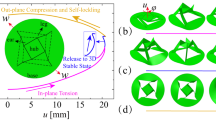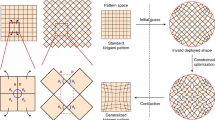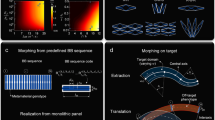Abstract
We present an additive approach for the inverse design of kirigami-based mechanical metamaterials by focusing on the empty (negative) spaces instead of the solid tiles. By considering each negative space as a four-bar linkage, we identify a simple recursive relationship between adjacent linkages, yielding an efficient method for creating kirigami patterns. This allows us to solve the kirigami design problem using elementary linear algebra, with compatibility, reconfigurability and rigid-deployability encoded into an iterative procedure involving simple matrix multiplications. The resulting linear design strategy circumvents the solution of a non-convex global optimization problem and allows us to control the degrees of freedom in the deployment angle field, linkage offsets and boundary conditions. We demonstrate this by creating a large variety of rigid-deployable, compact, reconfigurable kirigami patterns. We then realize our kirigami designs physically using two simple but effective fabrication strategies with very different materials. Altogether, our additive approaches present routes for efficient mechanical metamaterial design and fabrication based on ori/kirigami art forms.
This is a preview of subscription content, access via your institution
Access options
Access Nature and 54 other Nature Portfolio journals
Get Nature+, our best-value online-access subscription
$29.99 / 30 days
cancel any time
Subscribe to this journal
Receive 12 digital issues and online access to articles
$99.00 per year
only $8.25 per issue
Buy this article
- Purchase on Springer Link
- Instant access to full article PDF
Prices may be subject to local taxes which are calculated during checkout




Similar content being viewed by others
Code availability
The kirigami design codes are available on Zenodo24.
References
Callens, S. J. & Zadpoor, A. A. From flat sheets to curved geometries: origami and kirigami approaches. Mater. Today 21, 241–264 (2018).
Zhai, Z., Wu, L. & Jiang, H. Mechanical metamaterials based on origami and kirigami. Appl. Phys. Rev. 8, 041319 (2021).
Lang, R. J. Origami Design Secrets: Mathematical Methods for an Ancient Art (CRC Press, 2012).
Demaine, E. D. & O’Rourke, J. Geometric Folding Algorithms: Linkages, Origami, Polyhedra (Cambridge Univ. Press, 2007).
Hull, T. C. Origametry: Mathematical Methods in Paper Folding (Cambridge Univ. Press, 2020).
Temko, F. Kirigami, The Creative Art of Paper Cutting (Platt & Munk, 1962).
Borcea, C. & Streinu, I. Geometric auxetics. Proc. R. Soc. A 471, 20150033 (2015).
Chen, B. G.-g et al. Topological mechanics of origami and kirigami. Phys. Rev. Lett. 116, 135501 (2016).
Bertoldi, K., Vitelli, V., Christensen, J. & Van Hecke, M. Flexible mechanical metamaterials. Nat. Rev. Mater. 2, 17066 (2017).
Celli, P. et al. Shape-morphing architected sheets with non-periodic cut patterns. Soft Matter 14, 9744–9749 (2018).
Singh, N. & van Hecke, M. Design of pseudo-mechanisms and multistable units for mechanical metamaterials. Phys. Rev. Lett. 126, 248002 (2021).
Zheng, Y., Niloy, I., Celli, P., Tobasco, I. & Plucinsky, P. Continuum field theory for the deformations of planar kirigami. Phys. Rev. Lett. 128, 208003 (2022).
Czajkowski, M., Coulais, C., van Hecke, M. & Rocklin, D. Conformal elasticity of mechanism-based metamaterials. Nat. Commun. 13, 211 (2022).
Konaković-Luković, M., Panetta, J., Crane, K. & Pauly, M. Rapid deployment of curved surfaces via programmable auxetics. ACM Trans. Graph. 37, 106 (2018).
Choi, G. P. T., Dudte, L. H. & Mahadevan, L. Programming shape using kirigami tessellations. Nat. Mater. 18, 999–1004 (2019).
Jiang, C., Rist, F., Pottmann, H. & Wallner, J. Freeform quad-based kirigami. ACM Trans. Graph. 39, 1–11 (2020).
Choi, G. P. T., Dudte, L. H. & Mahadevan, L. Compact reconfigurable kirigami. Phys. Rev. Res. 3, 043030 (2021).
Dang, X., Feng, F., Duan, H. & Wang, J. Theorem for the design of deployable kirigami tessellations with different topologies. Phys. Rev. E 104, 055006 (2021).
Thompson, D. W. On Growth and Form (Cambridge Univ. Press, 1942).
Truby, R. L. & Lewis, J. A. Printing soft matter in three dimensions. Nature 540, 371–378 (2016).
Dudte, L. H., Choi, G. P. T. & Mahadevan, L. An additive algorithm for origami design. Proc. Natl Acad. Sci. USA 118, e2019241118 (2021).
Dudte, L. H., Vouga, E., Tachi, T. & Mahadevan, L. Programming curvature using origami tessellations. Nat. Mater. 15, 583–588 (2016).
Lang, R. J. & Howell, L. Rigidly foldable quadrilateral meshes from angle arrays. J. Mech. Robot. 10, 021004 (2018).
Dudte, L. H., Choi, G. P. T., Becker, K. P. & Mahadevan, L. ‘Additive kirigami’. Zenodo https://doi.org/10.5281/zenodo.7763613 (2023).
Acknowledgements
This work was supported in part by the National Science Foundation under grants nos. DMS-2002103 (G.P.T.C.), DMR 20-11754 (L.M.), DMREF 19-22321 (L.M.) and EFRI 18-30901 (L.M.), and the Simons Foundation (L.M.) and the Henri Seydoux Fund (L.M.).
Author information
Authors and Affiliations
Contributions
L.H.D. and L.M. conceived the research. L.H.D., G.P.T.C., K.P.B. and L.M. designed the research. L.H.D. and G.P.T.C. derived the theoretical results, implemented the algorithms and conducted the numerical experiments. K.P.B. built the physical models. L.H.D., G.P.T.C., K.P.B. and L.M. analyzed the results and wrote the manuscript. L.M. supervised the research.
Corresponding author
Ethics declarations
Competing interests
The authors declare no competing interests.
Peer review
Peer review information
Nature Computational Science thanks Xianqiao Wang, Alberto Corigliano and the other, anonymous, reviewer(s) for their contribution to the peer review of this work. Primary Handling Editor: Kaitlin McCardle, in collaboration with the Nature Computational Science team.
Additional information
Publisher’s note Springer Nature remains neutral with regard to jurisdictional claims in published maps and institutional affiliations.
Supplementary information
Supplementary Information
Supplementary Sections 1–4, Figs. 1–23 and discussion.
Source data
Source Data Fig. 3
Raw numerical source data for Fig. 3c.
Rights and permissions
Springer Nature or its licensor (e.g. a society or other partner) holds exclusive rights to this article under a publishing agreement with the author(s) or other rightsholder(s); author self-archiving of the accepted manuscript version of this article is solely governed by the terms of such publishing agreement and applicable law.
About this article
Cite this article
Dudte, L.H., Choi, G.P.T., Becker, K.P. et al. An additive framework for kirigami design. Nat Comput Sci 3, 443–454 (2023). https://doi.org/10.1038/s43588-023-00448-9
Received:
Accepted:
Published:
Issue Date:
DOI: https://doi.org/10.1038/s43588-023-00448-9
This article is cited by
-
Physics-aware differentiable design of magnetically actuated kirigami for shape morphing
Nature Communications (2023)



